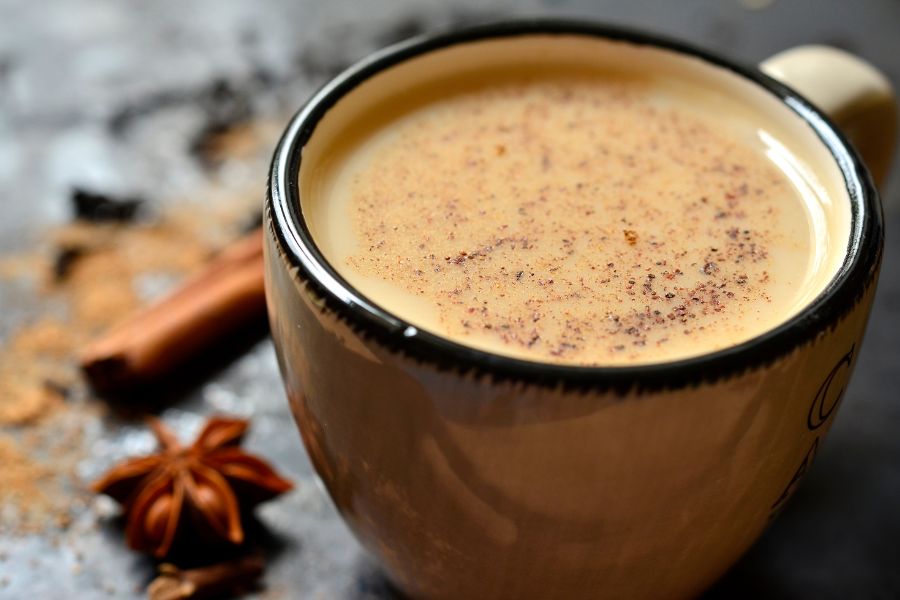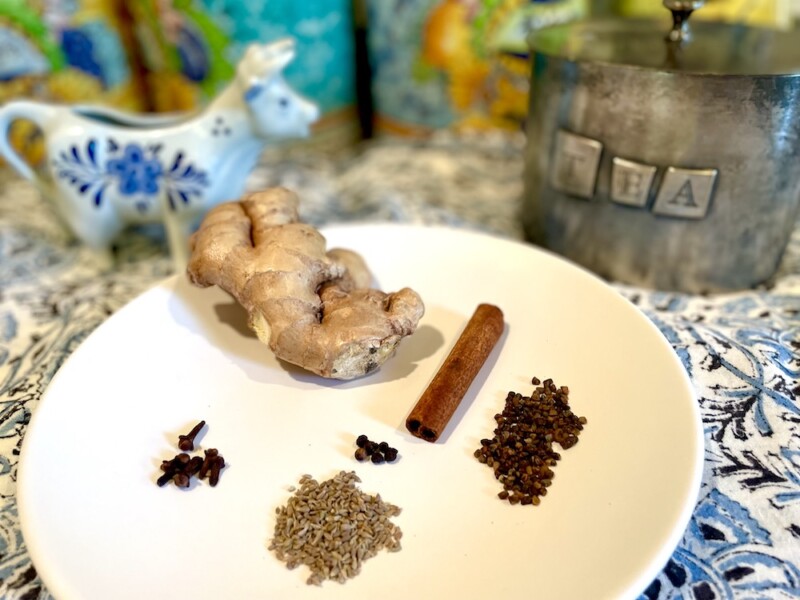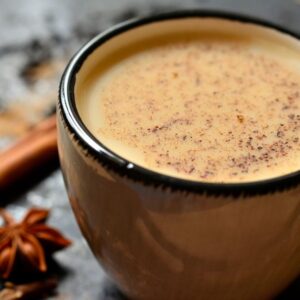This week, Diwali, the Hindu festival of light, honors the light in all of us everywhere. Celebrate the holiday and the spirit behind it with a cup of chai. Chai, India’s spiced tea, lights up your senses and warms you up, body and soul.

Chai, also called masala tea, is black tea infused with warming spices and mellowed with milk. Fellow vegans, skip the cow, go for plantbased milk. Oat milk in particular makes amazing, creamy chai.
If what you know of chai is Starbucks chai latte, that’s a start, but in Indian households — and mine — the chai of choice is homemade. DIY chai is easy, quick and — okay I’ll say it — better, richer, more rewarding — than what you get from a prepackaged blend. Besides, chai isn’t a hard and fast recipe, nor is it meant to be. Everyone makes it their own, and everyone swears theirs is the best. Including me.
Jump to the recipe or stick around for chai chat.How to Make
- Drop spices into a pot of water. Bring to a boil.
- Cover pot, turn off the heat, and keep the pot on a the burner, to let the spices infuse the water.
- After 10 minutes, drop in 3 teabags of black tea.
- Let that steep for few minutes.
- Fish out the teabags and strain the spices.
- Add 1 cup of unsweetened plain plantbased milk to the spiced tea.
- Heat through, sweeten as desired, and you’ve got chai.
Tips
- Chai is the Hindi word for tea. So when people say chai tea, they’re basically saying tea tea. Show you’re a pro. Just call it chai or masala (which means spiced) tea.
- For a drink that soothes, everything about chai sparks controversy, including how you make it. Some people are big on the double boil method, bringing your spices and tea to a boil once, then adding the milk and boiling again. I’m more of a simmering and steeping sort. But I agree, chai is best made in stages. First, you infuse the hot water with spices, then you add the tea, and finally, you add the milk and sweetness.
- Chai requires black tea. I use decaffeinated, because I’m a nervous person.
- Superior chai calls for using whole spices, not powdered spices.
- Fresher whole spices make better chai. If your pantry is full of pre-pandemic spices, it’s time to refresh.
- Chai is meant to be enjoyed sweetened and spiced. Starbucks chai is sweet and cinnamony, all right, but making your own lets you control the amount of sweetness and layer on the spices with greater nuance.

My chai spice blend contains:
- chopped fresh ginger
- cinnamon stick
- cardamom seeds — not the green cardamon pods, the tiny black seeds within — they’re fragrant, mildly citrusy and also known as grains of paradise
- clove — for spark
- anise seed — sweet and mildly licoricey
- black peppercorns — pepper? You bet. Just a few peppercorns add a gentle warmth
Want more elaborate? Other chai spices may include:
- mace — nutmeg’s bossier sibling
- dried orange peel
- dried rose petals
- star anise
- fennel
- turmeric
- saffron
Chai backstory:
India has a history of steeping spices in water. It’s part of the 3,000-year old healing practice known as Ayurveda. Tea itself, however, wasn’t always big in India. It came with the Brits, when they colonized the nation in the mid to late 1800s. The Brits drink their tea with milk. You can’t blame the Indians for thinking the English were crazy.
The Brits tried — and often — coerced — Indians into drinking tea. No go. Until the Indians decided if they were going to drink tea, they would do it on their own terms. By spicing it. Chai is both genius culinary fusion and a sly victory over colonialism. I’ll drink to that.
Chai was love at first sip for me. When I was vegetarian, my local Indian restaurant made chai that was creamy, soothing, spicy and aromatic — just what chai should be — except for the milk. I loved their chai so much, they’d start making a fresh pot when I walked in the door. When I went vegan, I gave it up. With a vast reluctance. Then I started experimenting by making chai at home using plantbased milk. Soy and almond milk were . . . okay. But when oat milk became available, the game changed and the chai angels sang for me again. I hope they sing for you.
A soothing, fragrant cup of chai makes Diwali — or any day — a celebration. Cheers!

Chai
Ingredients
- 4 cups water
- 1 tablespoon fresh ginger chopped
- 1 cinnamon stick
- 1/2 teaspoon cardamom seeds
- 6 whole cloves
- 3/4 teaspoon anise seed
- 6 whole black peppercorns
- 3 black teabags
- 1 cup plantbased milk — unsweetened plain oat milk is excellent
- sweetener of choice
Instructions
- Bring the water to boil in a medium saucepan. Drop in all the spices — ginger, cinnamon, cardamom, cloves, anise seed, and pepper.
- Turn off the heat, place the lid on the pot, and keep the pot on a the burner.
- Leave the spices to infuse the water for about 10 minutes.
- Then drop in 3 teabags of black tea. Decaffeinated black tea works, too. Let the tea and spices steep for few minutes.
- Fish out the teabags and strain the spices
- Add 1 cup of unsweetened plain plantbased milk to the spiced tea.
- Heat through, sweeten as desired, and you’ve got chai.
Notes
Full Fine Indian Feast for Diwali — Or Any Day
- Start the party with samosas, delectible spiced parcels, recipe from Gaz Oakley.
- Kitchri, an aromatic blend of rice, lentils and spices, is not only comforting, and delicious, it’s part of Ayurvedic healing.
- Make rich, roasted tandoori vegetables, even without a tandoor (Indian clay oven).
- Vegetable bhaji is quick, easy stir-fry, livened with mustard seed, cumin, turmeric and coconut.
- Diwali is all about sweetness, so enjoy these vegan and veganized mithai — sweet Indian bites — from Vegan Richa.
- Kheer — Indian rice pudding — is a Diwali tradition. Give my recipe an Indian spin. Skip the vanilla and substitute 1/2 teaspoon rose water. You can also add a few stamens of saffron to the simmering plantbased milk.
- Finish with a cup of chai and fresh fruit with chaat masala, or as I call it, magic dust.

Leave a Reply